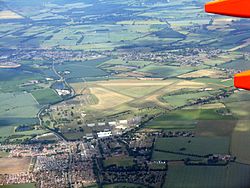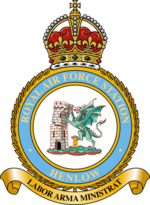RAF Henlow facts for kids
Quick facts for kids RAF Henlow
|
|||||||||||||
|---|---|---|---|---|---|---|---|---|---|---|---|---|---|
| Henlow, Bedfordshire in England | |||||||||||||

RAF Henlow from above
|
|||||||||||||

|
|||||||||||||
|
Shown within Bedfordshire
|
|||||||||||||
| Coordinates | 52°00′56″N 000°18′12″W / 52.01556°N 0.30333°W | ||||||||||||
| Type | RAF training station | ||||||||||||
| Site information | |||||||||||||
| Owner | Ministry of Defence | ||||||||||||
| Operator | Royal Air Force | ||||||||||||
| Controlled by | No. 2 Group | ||||||||||||
| Site history | |||||||||||||
| Built | 1918 | ||||||||||||
| Built by | McAlpine (1918) various since |
||||||||||||
| In use | 1918–Present | ||||||||||||
| Garrison information | |||||||||||||
| Current commander |
Wing Commander Chris Brooke | ||||||||||||
| Occupants |
|
||||||||||||
| Airfield information | |||||||||||||
| Identifiers | ICAO: EGWE | ||||||||||||
| Elevation | 51.2 metres (168 ft) AMSL | ||||||||||||
|
|||||||||||||
Royal Air Force Henlow or more simply RAF Henlow is a Royal Air Force station in Bedfordshire, England, equidistant from Bedford, Luton and Stevenage. It houses the RAF Centre of Aerospace Medicine, the Joint Arms Control Implementation Group (JACIG) and the Signals Museum. It formerly hosted light aircraft flying and 616 Volunteer Gliding Squadron. The Ministry of Defence announced on 6 September 2016 that the base is set to be close. As of January 2024, the closure and disposal of the station is expected to take place from 2026. Flying activity ceased in July 2020.
Contents
History
Henlow was chosen as a military aircraft repair depot in 1917 and was built by MacAlpine during 1918. Four Belfast Hangars were built and are now listed buildings. Henlow Camp, a civilian settlement, grew up around the base at that time.
Originally a repair depot for aircraft from the Western Front, the Station officially opened on 18 May 1918 when Lt Col Robert Francis Stapleton-Cotton arrived with a party of 40 airmen from Farnborough. In May 1920, RAF Henlow became the first parachute testing centre and was later joined by another parachute unit from RAF Northolt. Parachute testing was undertaken with Vimy aircraft and parachutists hanging off the wings and allowing the chute to deploy and enable them to drift back to the ground. The Officers Engineering School moved there in 1924 from Farnborough.
After the First World War, Henlow was home to four aircraft squadrons; No. 19 Squadron RAF, No. 23 Squadron RAF, No. 43 Squadron RAF and No. 80 Squadron RAF. Between 1932 and 1933, Sir Frank Whittle was a student at the RAF technical College on the base. He later spent some time in charge of aero engine testing on the base before being sent to Cambridge. An additional hangar was added to the inventory in the 1930s and this too is now listed.
During the Second World War Henlow was used to assemble the Hawker Hurricanes which had been built at the Hurricane factory operated by Canadian Car and Foundry in Fort William, Ontario, Canada, under the leadership of Elsie MacGill. After test flying in Fort William, they were disassembled and sent to Henlow in shipping containers and reassembled. During Operation Quickforce in 1941, 100 fitters from the base were deployed onto carriers which were shipping Hurricane fighters to Malta. The finished Hurricanes were completed on the decks of the carriers and flown out to Malta. Over 1,000 Hurricanes (about 10% of the total) were built by Canadian Car and Foundry and shipped to Henlow. Henlow was also used as a repair base for many aircraft types under the direction of No. 13 Maintenance Unit.
The empty packing crates that the Hurricane aircraft were shipped in were used to make the original control tower (which has now been replaced by a more modern two-storey Portakabin type). The original tower and parts of the airfield were seen in several scenes in the 1969 war film 'The Battle of Britain'.
A major RAF technical training college was also formed at Henlow in 1947. This was formed from the RAF School of Aeronautical Engineering, formerly at RAF Farnborough, and its purpose was to train cadets and engineering officers. The college was amalgamated with RAF College Cranwell in 1965. The RAF Officer Cadet Training Unit then moved in, but this also moved to Cranwell in 1980.
Henlow then hosted the RAF Signals Engineering Establishment and the Radio Engineering Unit, established in 1980. In 1983, the Land Registry took over part of the site.
In December 2011, RAF Henlow along with 14 other Ministry of Defence sites in the United Kingdom were designated as being dangerously radioactive. The 15 bases were believed to be poisoned as a consequence of undetermined activity during the Second World War.
Administratively, RAF Henlow was part of a combined base, RAF Brampton Wyton Henlow, until RAF Brampton was closed in 2013.
Flying activity ceased in July 2020.
Based units
Notable units based at RAF Henlow.
Royal Air Force
No. 2 Group (Air Combat Support)
- Air Security Force
- Forensic Exploitation Flight
- Digital Forensic Team
- Scientific Support Unit
- Forensic Exploitation Flight
- RAF Medical Services
- RAF Centre of Aerospace Medicine
- Centre of Aerospace Medicine Headquarters
- Aviation Medicine Wing
- Occupational and Environmental Medicine Wing
- Support Wing
- RAF Centre of Aerospace Medicine
British Army
- 11th Security Force Assistance Brigade
- Outreach Group
Strategic Command
Directorate of Overseas Bases
- Joint Arms Control Implementation Group (JACIG)
Other
- Signals Museum
Former units
The following units were here at some point:
- No. 19 Squadron RAF
- No. 23 Squadron RAF
- No. 43 Squadron RAF
- No. 80 Squadron RAF
- No. 1 Air Stores Park
- No. 1 AACU 'X' Flight
- No. 1 AACU 'Y' Flight
- No. 1 AACU 'Z' Flight
- No. 2 Air Stores Park
- No. 2 RAF Depot
- No. 2 Salvage Centre
- No. 3 Air Stores Park
- No. 3 Ferry Pool RAF
- No. 3 Salvage Centre
- No. 4 Salvage Centre
- No. 5 (Eastern) Aircraft Repair Depot
- No. 6 Air Stores Park
- No. 7 Air Stores Park
- No. 13 Maintenance Unit RAF
- No. 13 School of Technical Training RAF
- No. 14 School of Technical Training RAF
- No. 20 Air Stores Park
- No. 23 Wing Servicing Unit RAF
- No. 43 Group Communication Flight
- No. 49 Maintenance Unit RAF
- No. 106 Gliding School RAF
- No. 616 Gliding School RAF became No. 616 Volunteer Gliding School RAF
- No. 1959 Reserve Air Observation Post Flight RAF
- No. 1961 Reserve Air Observation Post Flight RAF
- No. 2709 Squadron RAF Regiment
- No. 2727 Squadron RAF Regiment
- Home Aircraft Depot
- Inland Area Aircraft Depot
- Parachute Test Unit (Ministry of Supply)
- Pilotless Aircraft Section RAF
- Queen Bee Flight RAF
- Rapier Cold Trials Unit
- RAF School of Aeronautical Engineering (Officers)
- Signals Development Unit RAF became Radio Engineering Unit
- Tactical Police Wing
- Tactical Police Sqn
The Signals Museum
The Signals Museum, focused on the development of electronic communications by the RAF since the First World War, was established in 1999.
Future
On 6 September 2016, the Ministry of Defence (MOD) announced the planned closure of RAF Henlow, with a disposal date of 2020. By 2019, a staged drawdown and closure was expected to take place between 2020 and 2023. In January 2024, the MOD indicated that the closure and disposal would take place from 2026.
See also
- List of Royal Air Force stations


